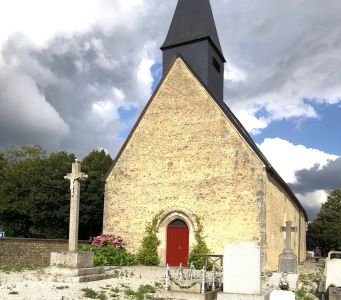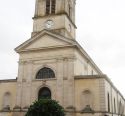Church | XII-XIV-XIX | Romanesque | Catholic Church



Map
Opening hours
01 July - 31 August
Mon 10.00 - 18.00
Tue 10.00 - 18.00
Wed 10.00 - 18.00
Thu 10.00 - 18.00
Fri 10.00 - 18.00
Sat 10.00 - 18.00
Sun 10.00 - 18.00
15 December - 06 January
Mon 10.00 - 17.00
Tue 10.00 - 17.00
Wed 10.00 - 17.00
Thu 10.00 - 17.00
Fri 10.00 - 17.00
Sat 10.00 - 17.00
Sun 10.00 - 17.00
Religious offices
Description
Donated in 1060 by Roger II de Montgomery and Mabile de Bellême to the nearby abbey of Saint-Martin de Sées, it has a single nave ending in a flat chevet lit by a triplet that replaced a cul-de-sac apse in the 13th century. Dating from the Romanesque period, it has retained walled bays on the north façade and a doorway on the south side. Its openings, including the large portal and its geminated Gothic windows, bear witness to major changes in the 13th century. The bell tower was rebuilt around 1830.
Translated with DeepL.com (free version)
Photos
Remarkable elements
Low relief
Three scenes from the Nativity cycle - the Annunciation, the Adoration of the Shepherds and the Adoration of the Magi - follow one another in this ‘altarpiece’, composed in 1862 when these elements were transferred from the chapel of the Médavi manor house, on the southern edge of the parish. These limestone bas-reliefs, similar to those produced in the workshops of the Loire region in the 16th century, are set in a richly sculpted frame using Renaissance ornamental vocabulary.
Listed as historic monuments in 1996, they were restored in 2023.
Translated with www.DeepL.com/Translator (free version)
Stained glass window of sainte Eulalie
The only surviving piece of the old stained glass destroyed by hail in 1846 and listed as a historic monument in 1905, this stained glass window is thought to be the work of the same workshop as some of the stained glass windows in Sées Cathedral, installed at the end of the 13th century. Composed of figures set in a grisaille and a border of fleurs-de-lys and Castilian castles, it depicts the beheading of Eulalie, a Spanish martyr whose cult was well established in France in the early Middle Ages.
Translated with www.DeepL.com/Translator (free version)
High altar ensemble
Made of painted and gilded wood, it comprises an altarpiece from the second half of the 18th century, a 17th-century tabernacle with wings and a tomb altar adorned with a medallion depicting the mystic lamb. Two Corinthian columns flank the central panel of the altarpiece with its limited decoration: garlands surrounding the altarpiece, acanthus leaves on the side scrolls, foliage running along the right-hand entablature. A niche with a broken pediment flanked by fins houses a stone statue of Saint Eulalie at the top. The altar painting, signed by Charles Louis Dufresne and dated 1699, illustrates the dogma of the Trinity, the church's former dedication.
Listed as a historic monument.
Translated with www.DeepL.com/Translator (free version)
Statue of Saint John the Baptist
Made of carved oak, this statue of the saint wearing a large camel's hair tunic is part of local folk art.
Translated with www.DeepL.com/Translator (free version)
Statue of Saint Eulalie
Discovered in 1804 in a ploughed field, she suffered greatly from her time in the open ground, and her clothes disguise her state of decay. She is invoked against childhood illnesses, Eulalie having been martyred in Spain at the age of 12 according to her legend dating from the 8th century.
Listed as a historic monument.
Translated with www.DeepL.com/Translator (free version)
Virgin of mercy
This 16th-century sculpted group in white stone, listed as a historic monument, is a masterpiece of statuary. The sorrowful expression of the Virgin with clasped hands and the forlorn attitude of Christ, with his calm face and slumped body, are the work of an artist who mastered his means of expression. The group was commissioned in memory of her husband by the widow of Raoul de Mallard, who was killed in action at Marignan, and comes from the chapel of the Médavi manor house, consecrated in 1531. It was originally painted, leaning against a cross and flanked by two bas-reliefs depicting the instruments of the Passion. It was recently restored in July 2024.
Translated with www.DeepL.com/Translator (free version)










